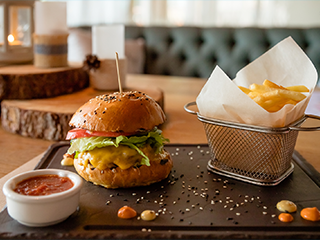
Whether its fried, feathered, frozen or fresh, there’s no shortage of food retailing options in the franchise sector.
If you plan to make your fortune on food, there’s one thing you should consider; what model is going to generate the greatest cashflow.
Here Inside Franchise Business takes a look at four fabulous food options, each with their own pros and cons to help you make the operational decision with confidence.
Drive-through
Putting the ‘fast’ in fast-food, drive throughs have become a staple of the Aussie food retailing landscape. You’d be hard-pressed to travel anywhere in the nation’s metropolitan districts without bathing in the glow of McDonald’s golden arches, or signs for the colonel’s car-friendly concept, but it isn’t just burger brands getting in on the action.
A recent trend towards quick service cafes has seen a rising demand for drive-through coffee shops and grab and go breakfast options.
Queensland-based coffee franchise, Zarraffa’s Coffee launched its drive-through model in 2009 and has gradually developed an extensive network of multi-unit franchisees and partners.
Kenton Campbell, Zarraffa’s managing director said the implementation of a drive-through offering to the coffee sector provided an innovative solution for time-poor Australians who value barista-made coffee.
“The inception of our drive-through stores in 2009 enabled us to choose higher traffic sites within densely populated markets that ultimately help boost business and ensures our franchisees can be successful,” Campbell said.
Many franchise brands are now seeing drive-throughs as a natural addition, due to their ability to generate strong revenue, Mark Godward, former Taco Bell operations engineering manager and current principal of Foodservice Productivity Group said.
“With food, typically the ticket is between $3 and $10, so there’s a significant amount of money [to offset the] labour it takes to run the drive-thru,” Godward told Entrepreneur.com.
If you’re dealing with food, convenience and cost will help boost your bottom line.
Cafe
A more traditional bricks and mortar food retailing model, the cafe scene in Australia has grown steadily over the past five years, reaching an annual revenue of $8b.
According to market research company IBISWorld, the trend is set to continue, following a large spike in positive consumer sentiment and growing household incomes, particularly in regional areas.
A major challenge for the cafe model however, is increasing rental costs, especially those in high footfall areas such as shopping centres, where there is already a steady number of competitors, both franchised and independent.
An emerging market for the cafe scene comes in the form of regional districts, which provide franchisees with a less competitive environment, stronger community focus and ability to incorporate localised marketing solutions.
Franchise salad, sandwich and coffee brand Soul Origin implemented regional growth tactics as part of its expansion strategy, due to the tight knit community mentality and ability to engage with locals, giving franchisees the opportunity to develop brand loyalty.
The franchise has taken its model from the city centres of Sydney to rural areas of the Northern Territory and Western Australia, leveraging a strong brand name and offering.
Franchisees should note that dine-in models require increased business costs, such as staffing, rent and maintenance, meaning the average spend per customer must be higher in comparison to grab and go concepts.
Mobile
After watching the food truck scene take off in the U.S., Aussie foodies are developing a healthy appreciation for mobile food businesses and providers.
Due to the compact, no seating arrangement model, mobile food retailers have reduced overheads and employ few staff, meaning that the repayment period on the initial investment is greatly reduced.
Coffee and sandwich vendors have emerged as profitable breakfast and lunch options, identifying key areas such as children’s sporting grounds, construction sites and specialised events as prospective markets.
New Zealand founded, The Coffee Guy is an example of a low-cost, purpose designed coffee and snack mobile service, that provides franchisees with dedicated geographic territory.
The franchise opportunity cuts down on costs, providing a one man business with the ability to operate all day, boosting profits.
A key benefit for franchisees is the ability to alter destination and promote locally, taking advantage of community events and functions.
Delivery
Contemporary consumers are often spoilt for choice when it comes to food offering, so implementing a series of strategies that bring the business to their door can help generate market share and revenue.
Businesses that offer delivery services are growing in stature, however, to accommodate evolving consumer demand, they must have a firm focus on innovation and technology.
In 2014, pizza franchise giant, Domino’s saw the impact market disruptors such as Uber were having on other industries and quickly identified a need for an on-demand driver location service to complement its delivery platform, introducing the “GPS Driver Tracker App”.
Delivery platforms like UberEats and Deliveroo continue to increase network coverage, providing food retailers with easier access to market share, however, charge a service fee, usually calculated as a percentage of your sales through the platform.
These users are quickly becoming a market that can’t be ignored however, with research company Morgan Stanley predicting that digital food delivery may comprise 11 per cent of total food retailing sales by 2022, compared to just six per cent in 2017.
With online orders expected to hit $4b by 2025, delivery-based food retailing is a growing market with no shortage of opportunities, with the potential to overtake the traditional takeaway concept.
Final word
If food is your future, a key undertaking in your due diligence process should be market research.
Understanding the needs of your local community, how they value the delivery mechanics of the food offerings they purchase, and what competitors in your area are already offering will help you to make an informed decision.

